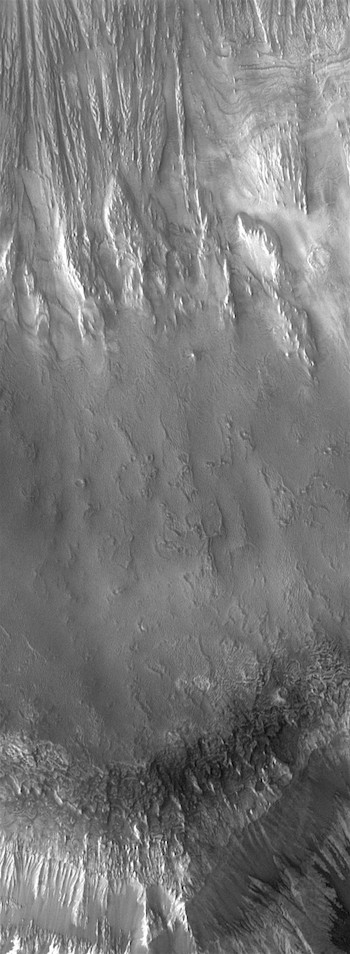 THEMIS Image of the Day, August 17, 2017. The large mesa in the center of Hebes Chasma dominates this image. The top of the mesa is at the center of the image, with the cliff faces to the top and bottom of the image. The layering of the mesa is most easily identified in the lower part of the image. The long linear depression on the northern face indicate that wind action played a large part in eroding the mesa.
THEMIS Image of the Day, August 17, 2017. The large mesa in the center of Hebes Chasma dominates this image. The top of the mesa is at the center of the image, with the cliff faces to the top and bottom of the image. The layering of the mesa is most easily identified in the lower part of the image. The long linear depression on the northern face indicate that wind action played a large part in eroding the mesa.
Hebes Chasma is an enclosed basin not connected to Valles Marineris. The cliff faces of the chasma itself and the interior mesa appear quite different, which may provide information on how the chasma and the mesa formed. (More on Hebes Chasma: http://bit.ly/2fFmJTq)
NASA’s Mars Odyssey spacecraft has spent over 15 years in orbit around Mars, circling the planet more than 69,000 times. It holds the record for longest working spacecraft at Mars. THEMIS, the IR/VIS camera system, has collected data for the entire mission and provides images covering all seasons and lighting conditions.
Over the years many features of interest have received repeated imaging, building up a suite of images covering the entire feature. From the deepest chasma to the tallest volcano, individual dunes inside craters and dune fields that encircle the north pole, channels carved by water and lava, and a variety of other feature, THEMIS has imaged them all.
For the next several months the Image of the Day will focus on the Tharsis volcanoes, the various chasmata of Valles Marineris, and the major dunes fields. We hope you enjoy these images!
More THEMIS Images of the Day by geological topic.








